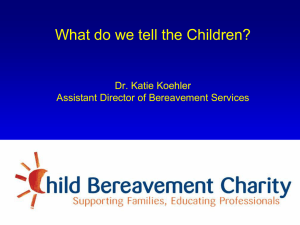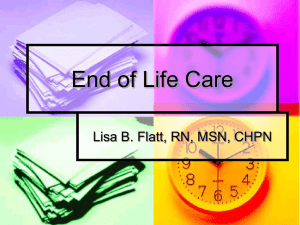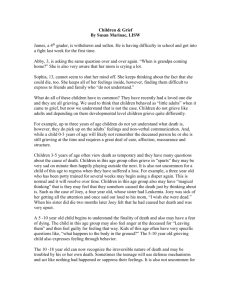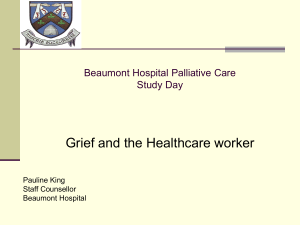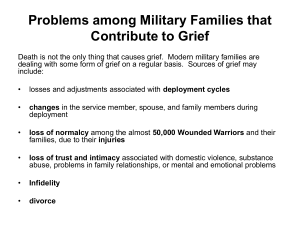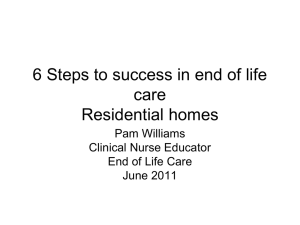SIGCHI Conference Paper Format
advertisement
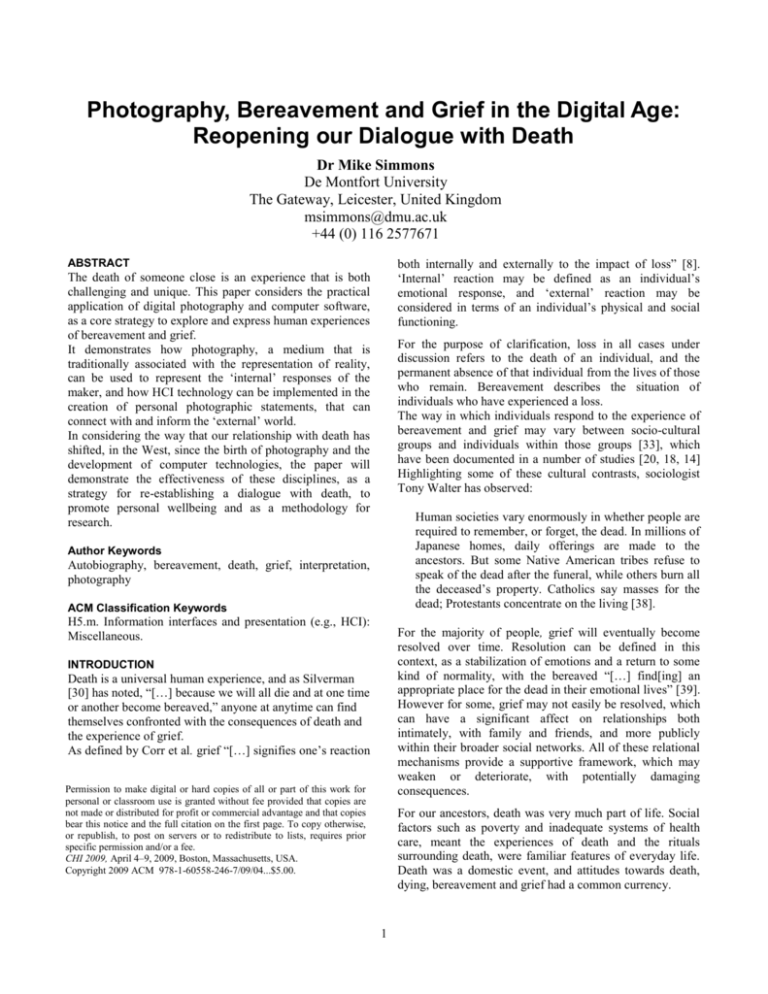
Photography, Bereavement and Grief in the Digital Age: Reopening our Dialogue with Death Dr Mike Simmons De Montfort University The Gateway, Leicester, United Kingdom msimmons@dmu.ac.uk +44 (0) 116 2577671 both internally and externally to the impact of loss” [8]. ‘Internal’ reaction may be defined as an individual’s emotional response, and ‘external’ reaction may be considered in terms of an individual’s physical and social functioning. ABSTRACT The death of someone close is an experience that is both challenging and unique. This paper considers the practical application of digital photography and computer software, as a core strategy to explore and express human experiences of bereavement and grief. It demonstrates how photography, a medium that is traditionally associated with the representation of reality, can be used to represent the ‘internal’ responses of the maker, and how HCI technology can be implemented in the creation of personal photographic statements, that can connect with and inform the ‘external’ world. In considering the way that our relationship with death has shifted, in the West, since the birth of photography and the development of computer technologies, the paper will demonstrate the effectiveness of these disciplines, as a strategy for re-establishing a dialogue with death, to promote personal wellbeing and as a methodology for research. For the purpose of clarification, loss in all cases under discussion refers to the death of an individual, and the permanent absence of that individual from the lives of those who remain. Bereavement describes the situation of individuals who have experienced a loss. The way in which individuals respond to the experience of bereavement and grief may vary between socio-cultural groups and individuals within those groups [33], which have been documented in a number of studies [20, 18, 14] Highlighting some of these cultural contrasts, sociologist Tony Walter has observed: Human societies vary enormously in whether people are required to remember, or forget, the dead. In millions of Japanese homes, daily offerings are made to the ancestors. But some Native American tribes refuse to speak of the dead after the funeral, while others burn all the deceased’s property. Catholics say masses for the dead; Protestants concentrate on the living [38]. Author Keywords Autobiography, bereavement, death, grief, interpretation, photography ACM Classification Keywords H5.m. Information interfaces and presentation (e.g., HCI): Miscellaneous. For the majority of people, grief will eventually become resolved over time. Resolution can be defined in this context, as a stabilization of emotions and a return to some kind of normality, with the bereaved “[…] find[ing] an appropriate place for the dead in their emotional lives” [39]. However for some, grief may not easily be resolved, which can have a significant affect on relationships both intimately, with family and friends, and more publicly within their broader social networks. All of these relational mechanisms provide a supportive framework, which may weaken or deteriorate, with potentially damaging consequences. INTRODUCTION Death is a universal human experience, and as Silverman [30] has noted, “[…] because we will all die and at one time or another become bereaved,” anyone at anytime can find themselves confronted with the consequences of death and the experience of grief. As defined by Corr et al. grief “[…] signifies one’s reaction Permission to make digital or hard copies of all or part of this work for personal or classroom use is granted without fee provided that copies are not made or distributed for profit or commercial advantage and that copies bear this notice and the full citation on the first page. To copy otherwise, or republish, to post on servers or to redistribute to lists, requires prior specific permission and/or a fee. CHI 2009, April 4–9, 2009, Boston, Massachusetts, USA. Copyright 2009 ACM 978-1-60558-246-7/09/04...$5.00. For our ancestors, death was very much part of life. Social factors such as poverty and inadequate systems of health care, meant the experiences of death and the rituals surrounding death, were familiar features of everyday life. Death was a domestic event, and attitudes towards death, dying, bereavement and grief had a common currency. 1 Advances in health and social care have extended life expectancy. Along with increased longevity, modernity has also relocated death from the home to the hospital and nursing home. Although over half a million people die in Britain every year, we now rarely witness death first hand [23]. Social changes in Western attitudes to death, dying, bereavement and grief have shifted from the familiar, established and “[…] elaborate mourning rituals of the nineteenth century,” [15] to a position, which in an increasingly secularised and individualistic modern age, lack ritual and reject death [1, 25, 14]. In broadening their scope, photography and HCI technology have provided new opportunities for visualization, communication and understanding, which can be implemented to partially address issues surrounding bereavement and grief. AUTOBIOGRAPHY, INTERPRETATION AND HEALING Whatever our background, our lives are mediated by our personal, social and cultural exchanges. Understanding our position within that system is informed by our lived experiences. Making sense of whom we are, and what has happened to us, is a direct result of renegotiating our past in the present. The relationships we develop and the attachments we make shape our lives, and through those intimate connections, our understanding of the physical world is formed, and our position within its precincts defined. The bonds we make inevitably bind us through physical and emotional ties, providing us with stability and a foundation on which we build our identity. In the West today, we often view death as something that happens to other people [13]. Modernity, despite its technological accomplishments, has removed a vital link in our social, cultural and spiritual relationship with death [26, 34]. Grief is a consequence of living, and as such is a diverse, complex and challenging part of our ongoing lives. Can a framework be developed using photographic practice and HCI technology, to restore our dialogue with death? It is a process, which informs our position in the world, by developing a sense of “self” [30] and providing a “memory structure” on which to establish order and create meaning within our lives [4]. As Sociologist Gordon Riches has written: Taking this question as its point of departure, this paper considers the ways in which the practical application of these specific elements, have been utilized to redefine our relationship with death, providing an opportunity for bereavement support and a research strategy for the study of bereavement and grief. This project that is ‘me’ requires that I stock-take these moments, that I arrange them in order, that I set them out into a biographical narrative that show the threads of my life from its beginning to the present moment - and beyond into hopes, fears and strategies for the future [28]. PHOTOGRAPHY, HISTORY AND MODERNITY Since its inception, photography has had an association with death and human adaptation to grief. Posthumous photography became an accepted ritual in nineteenth century Europe and America [5, 29]. These images were often the only photographic record of an individual, especially children, and they frequently portrayed the dead as sleeping. They provided a focus for grief and mediation with the realities of death. As Linkman has commented: A portrait of the dead at peace could help alleviate the anguish caused to the bereaved by a painful or tragic end. While portraits of those who had died a 'good' death could serve as an example and role model for the living [22]. The role of the photograph, to bear witness, has remained an important characteristic of the medium. However, advances in computing have taken place, which challenge photography’s core values, shifting the terms by which we relate to the photograph, how we retrieve, experience, and read it. We are now in an era where technological advancement within photography and HCI, have provided a wide range of easily accessible resources for personal expression, widening participation in a medium, which through traditional silver-based practice, would have required specialist skills, knowledge, equipment and environments. Figure 1. Image created at a Pictures From Life workshop. Pictures From Life (Figure. 1), is a new and innovative UK based workshop programme, which has incorporated photographic and HCI technology, in a health related setting, to provide support for children and young people (primarily between the ages of 8 and 16) and their families, 2 who are experiencing difficulties following a significant family death [32]. The programme provides cross-agency collaboration, bringing together the skills and experience of a professional specialist social worker and a photographic artist, allied in facilitating a healthy grieving process. about by the death of a significant person in our lives, relates not only to the permanent absence of that individual, but also to the social roles associated with them. As Bermann has observed: In her death we were dying as well. Mother and daughters: what had been us was changing, because she was leaving it, she was leaving us behind, she was leaving what we were together [3]. Bereavement projects centered on children and young people in the UK, have grown over the last five to ten years, but are still relatively sporadic. Much of the work previously undertaken elsewhere in the UK, have been through support programmes, based on a counseling model of working, with less emphasis placed on the recognition of photographic practice and HCI as a medium for bereavement support. This initiative is the first of its kind in the County of Lincolnshire. For Berman perhaps, the practice of recounting the dead through story telling ‘[...] tells the story maker who the deceased was, and by extension who the story maker is’ [37]. Personal stories speak in ordinary terms often about extraordinary events. There value is in the telling, and their relevance is in the interpretation [10]. Sharing information in this way, provides is a vital means of human expression, communication and understanding. The development of academic research and professional practice regarding human aspects of death, dying, bereavement and grief, have emerged as a prolific, diverse and at times controversial area. Much of the theories and expert opinion has been largely expressed in scientific or clinical terms. In recent research it has been questioned as to whether this criteria is ‘[…] seeking to impose scientific structures on experiences better represented through poetic language or other artistic forms…?’ [21]. Research and professional practice using photography and HCI technology, as a sustained and systematic approach, has received less attention. Children and young people can often feel isolated in their experiences of loss and grief, and families may find it difficult to communicate with one another, about their feelings surrounding death. Children’s grief can be frequently misunderstood or even ignored, which can significantly affect relationships both at home and amongst peers, resulting in low self-esteem and isolation [19]. Creating opportunities to articulate experiences through photographic visualization, enhanced by HCI technology, provides a rich vocabulary to connect with, describe, and evaluate our lives in a positive and proactive way. By enabling children and young people to interpret their experiences in this way, has provided “[…] a valuable agent for therapeutic change” [9]. Such an approach has opened up a new and stimulating path to the exploration and expression of loss, which has provided a framework for the improvement of communication within the family, and in a wider social context, which has reduced isolation and promoted personal wellbeing. Engaging in such activity can play a significant role in the creation of positive emotions, such as optimism and contentment, in terms of understanding or defining the relationship between the survivor/s and the death experience. As Fredrickson has observed: Photography and HCI technology provide a means to translate and evaluate personal experiences of bereavement and grief, which might otherwise remain invisible, through more traditional modes of enquiry. It is a process that can help place the maker in a new relationship to their experiences, through the development of critical distance. A term, which describes the means whereby an experience or event can be understood, and its implications appreciated, from a more informed perspective. It can also extend the subjective processes developed through its creation, into an inter-subjective experience, as “[…] a focus for discussion” [7], in a broader social and critical context, as the work engages with an audience. As Ellis & Bochner have written: […] phenomenological, positive emotions may help people place events in their lives in broader context, lessening the resonance of any particular negative event. [11]. Understanding is not embedded in the experience as much as it is achieved through an ongoing and continuous experience of the experience [10]. As a catalyst for change, such a positive emotional engagement can provide an opportunity for rebuilding new and continuous relationships, which can assist in providing meaning for survivors, and help build psychological resilience [12]. It is a process, which may endure as the child or young person, grows through their lives [2, 11, 12]. NO ONE HOEME: SOCIAL CONTEXT DEATH RELATIONSHIPS AND This visual study (Figure. 2.) considers the role of memory within the altered physical and emotional landscape of a home, following the death of a close family member [24]. Home, so the saying goes ‘is where the heart is,’ an adage that stands as a metaphor for a significant personal relationship, both physical and emotional, with individuals or social groups and with specific spaces or places. INTERPRETING LIVED EXPERIENCE In Elements of the Month of our Dying, Bermann gives a moving account of the final weeks of her mother’s life, offering the reader a window into a personal view of the “[…] rituals of love and grief” [3]. The changes brought 3 Objects float above these elements inviting the formulation of links and associations. The image reproduced here can only give a sense of the work, as the technology employed, allows the content of the panels to seemingly project their information, in what appears to be three dimensions. Figure 2. From No One Home: death relationships and social context. Simmons 2005 The heart, in medieval times was seen to symbolize memory [6], and it has been argued that memory is shaped through our relationship with the physical world [27]. Often an amalgamation of many facets real and imagined, whatever our individual notion of ‘Home’ may be, its foundation will be one that is central to our psychological equilibrium, a focus of our identity and a symbol of stability. In the eighteenth century, it was commonplace to: The viewer can interact with the work by touching the panels. As they do their hands seem to pass through the various layers drawing the viewer into a familiar yet foreign territory [40]. The work demonstrates how the functionality of an artwork can be changed from something that is experienced rationally, as a “viewer” to something experienced emotionally, as a “participant” [35]. “[…] freeze the domestic interior. Stopping clocks at the hour of death, turning mirrors to the wall and draping black cloth over the pictures” [15]. In this is study, two related but alternative perspectives associated with the broader idea of ‘Home’ is explored. One is external, which finds expression in our relationships with people, objects and spaces, and our familiarity and intimacy with the practices we engage in with them. The other perspective is an emotional one, informed by those external influences, but articulated internally, through feelings of reassurance, comfort and belonging. The work is comprised of four computer generated lenticular panels. Lenticular technology uses rows of simple lenses to convey the illusion of three dimension or movement, from specifically prepared images. CONCLUSION Death transforms the lives of those who remain, forcing the bereaved to consider new beginnings; through which the acknowledgment and acceptance of emotional significance, shaped by personal events, can be negotiated. Regaining an emotional balance and redefining our personal and social roles are essential to the ‘[…] purpose and process of grief’ [36]. The focus of this paper has been to present a method, which has been implemented to foster positive emotional change through photography and HCI technology. Creating opportunities to articulate experiences, through such an approach, also provides an alternative strategy for the study of grief. It is a process through which knowledge and understanding can be transferred, improved and developed, allowing us once again to renew our dialogue with death. The panels, which incorporate photographs of the domestic space, silently place the viewer in relation to a recognizable environment, utilizing photography’s power to draw the viewer into its own time, and evoke a sense of familiarity, ordinariness, and continuity. But these images endeavor to go beyond the normal conventions of formal analysis. Portraits from the family album, that traditional and universal symbol for memory, with a format practiced and understood across the world as a system of storage and retrieval, offers tangible reminders of all that is good in our lives. These portraits have had their opacity digitally altered, to create a sense of estrangement, gazing with intensity into the eyes of the viewer, to create tension and unease. Photography and HCI technology offer an alternative method to the predominantly theoretical and textual discourse normally encountered within the subject domain. Together they offer mechanisms for creation and dissemination to provide a contemporary document and artistic reference, which has proven relevant in a broad range of inter-disciplinary contexts including health, education, research and the arts. 4 16. Hayslip, B. Peveto, C. A. Cultural changes in Attitudes Towards Death, Dying and Bereavement. New York, Springer Publishing Company Inc., 2005. REFERENCES 1. Aries, P. Western Attitudes Towards Death: from the Middle Ages to the Present, Baltimore, John Hopkins University Press, 1974. 17. Howarth, G. Grieving in public. In: Hockey, J. Katz, J. Small, N. (eds.), Grief, Mourning and Death Ritual, Buckingham, Open University Press, 2001, p. 247. 2. Aspinwall, L.G. 2001, Dealing with adversity: selfregulation, coping, adaptation and health. In: The Blackwell handbook of social psychology, vol. 1 (eds). Tessar, A. & Schwartz, N. pp. 591-614. Malden, MA, Blackwell. 18. Irish, D. P., Lunquist, K. F., Jenkins-Nelson, V. Ethnic Variations in Dying, Death and Grief: Diversity in Universality, London, Taylor & Francis, 1993. 3. Bermann, K. Elements of the Month of our Dying. In: n. paradoxa vol. 7, K. T. Press, London, 2001. 19. Job, N. & Francis, G. Childhood Bereavement: Developing the Curriculum and Pastoral Support. London, National Children’s Bureau, 2004 4. Brunner, J. Acts of Meaning, Cambridge, MA. Harvard University Press, p.12-13, 1990. 20. Kalish, R. A., Retnolds, D. K. Death and Ethnicity: A Psychocultural Study, New York, Baywood Publishing Company. 1976. 5. Burns, S. B. Sleeping Beauty, memorial photography in America, Los Angeles, CA., Twelvetrees Press, 1990. 6. Carruthers, M. J. The Book of Memory: A study in memory in medieval culture, Cambridge: Cambridge University Press, 1990. 21. Katz, J. Introduction. In: Hockey, J., Katz, J., Small, N. (eds.), Grief, Mourning and Death Ritual. Buckingham, Open University Press, 2001, p. 7. 7. Case, C. & Dalley, T. The Handbook of Art Therapy. East Sussex and Philadelphia Brunner and Routledge, 1992, p. 1. 22. Linkman, A. Taken From Life: post-mortem portraiture in Britain 1860-1910, in Mortality vol. 10 Supplement, 2005, p. 49. 8. Corr, C.A., Nabe, C.M. and Corr, D.M. Death and Dying, Life and Living. Pacific Grove, CA, Brooks/Cole, 1997. 23. Main, J. Improving management of bereavement in general practice based on a survey of recently bereaved subjects in a single general practice, In: British Journal of General Practice, vol. 50, 2000, pp. 863-866. 9. Dalley, T. (ed), Art as Therapy. London, Routledge, 1984, p. xii. 24. No One Home [Online image] Simmons, M. Available from: http://www.dmu.ac.uk/research/aad/researchprojects/photography-bereavement-grief/noh4.jsp [Accessed 4/01/2010]. 10. Ellis , C. Bochner, A. P. Telling and Performing Personal Stories. In: Ellis, C. and Flaherty, G. M. Investigating Subjectivity: Research on Lived Experience, London, Sage Publications Inc., 1992. P. 8. 25. Norbert, E. The Loneliness of Dying, London, Contiuum, 1985. 11. Fredrickson, B. L. & Joiner, S. Positive emotions trigger upward spirals towards well-being. In: Psychological Science, vol. 13, 2002, pp. 172-175. 12. Fredrickson, B. L. The broaden-and-build-theory of positive emotions. In: Philosophical transactions of the Royal Society of London. Series B, Biological sciences, September 29;359 (1449):1367-78. London, The Royal Society, 2004. 26. Percy, M. Our Fathers: childhood loss and memory, a touring exhibition organised by Mike Simmons and Barbara Hind [exhibition catalogue], Leicester,Simmons & Hind, 2002. 27. Radley, A. Artifacts, memory and a sense of the past. In: D. Middleton & D. Edwards eds. Collective Remembering. London, Sage, 1990. 13. Freud, S. Thoughts for the Times on War and Death. In: The Standard Edition of the Complete Psychological Works of Sigmund Freud, Vol. 4. London: Hogarth Press, 1953. 28. Riches, G. 2001, Our Fathers: childhood loss and memory, a touring exhibition organised by Mike Simmons and Barbara Hind [exhibition catalogue], Leicester, Simmons & Hind, p. 8. 14. Giddens, A. Modernity and Self-Identity, Oxford, Polity, 1991. 29. Ruby, J. Secure the Shadow: Death and Photography in America, Cambridge, MA. The MIT Press, 1995. 15. Hallam, E., Hockey, J. Death, Memory & Material Culture, Oxford, Berg, 2001, p. 118. 5 30. Shank, R. C. Tell Me A Story: Narrative Intelligence. Illinois, Northwestern University Press, 1990, p.115. and Barbara Hind [exhibition catalogue], Lincoln, Simmons & Hind, 2002. 31. Silverman, P. R. Research, Clinical Practice, and the Human Experience: Putting the Pieces Together. In: Death Studies, 2000, 24: 468-469. 35. Viola, B. De profundis, In: Art Review 1 no 11, 2003, p. 2. 36. Walter, T. A new model of grief: bereavement and biography. In: Mortality, vol 1, no. 1, 1996, p. 7-13. 32. Simmons, M. & Wilson, T. Pictures From Life: intervention and healing through creative photographic practice. A collaborative model in bereavement support for children, young people and their families. Proc. International Conference on Phototherapy and Therapeutic Photography, 2008, p. 26. 37. Walter, T. On Bereavement: The Culture of Grief, Buckingham, Open University Press, 1999, p. 71. 33. Snow, C. P. The Two Cultures: and a Second Look. Cambridge England, Cambridge University Press, 1965. 38. Walter, T 2002, Our Fathers: childhood loss and memory: a touring exhibition organised by Mike Simmons and Barbara Hind [exhibition catalogue]. Leicester, UK, 2002, p. 2. 34. Stokes, A. 2002, Our Fathers: childhood loss and memory, a touring exhibition organised by Mike Simmons 39. Worden, J. W. Grief Counselling and grief therapy, London, Routledge, 1991, p.16. 6
